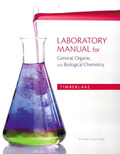
a.
To determine:
The effect of storing leftover in the refrigerator on the
Introduction:
Rate of the
b.
To determine:
The effect of increasing kinetic energy of reactant molecules on the rate of chemical reaction.
Introduction:
Rate of the chemical reaction is the amount of reactant consumed in the given reaction in the given period of time or it can be defined as the amount of product formed in the given reaction in the given period of time.
c.
To determine:
The effect of increasing frequency of collision on the rate of chemical reaction.
Introduction:
Rate of the chemical reaction is the amount of reactant consumed in the given reaction in the given period of time or it can be defined as the amount of product formed in the given reaction in the given period of time.
Want to see the full answer?
Check out a sample textbook solution
Chapter 5 Solutions
EBK LABORATORY MANUAL FOR GENERAL, ORGA
- . A(n) _______ speeds up a reaction without being consumed.arrow_forwardWhat is the general chemical equation for each of the following types of chemical reactions? a. Displacement reaction b. Combination reactionarrow_forwardIndicate to which of the following types of reactions each of the statements listed applies: combination, decomposition, displacement, exchange, and combustion. More than one answer is possible for a given statement. a. Two reactants are required. b. Only one reactant is present. c. Two products are present. d. Only one product is present.arrow_forward
- Indicate to which of the following types of reactions each of the statements listed applies: combination, decomposition, displacement, exchange, and combustion. More than one answer is possible for a given statement. a. An element may be a reactant. b. An element may be a product. c. A compound may be a reactant. d. A compound may be a product.arrow_forwardCalculate the amount of carbon dioxide (in kg) emitted into the atmosphere by the complete combustion of a 15.0 gallon tank of gasoline. Do this by following these steps: Assume that gasoline is composed of octane (C8H18). Write a balanced equation for the combustion of octane. Determine the number of moles of octane contained in a 15.0 gallon tank of gasoline (1 gallon = 3.78 L). Octane has a density of 0.79 g/mL. Use the balanced equation to convert from moles of octane to moles of carbon dioxide, then convert to grams of carbon dioxide, and Finally to kg of carbon dioxide.arrow_forwardHydrogen chloride gas dissolves in water to form hydrochloric acid (an ionic solution). HCl(g)H2OH+(aq)+Cl(aq) Find H for the above reaction. The data are given in Table 6.2.arrow_forward
- What is the general chemical equation for each of the following types of chemical reactions? a. Exchange reaction b. Decomposition reactionarrow_forwardChemical Equilibrium If the Chemical Equilibrium is 2, and a reaction is begun with 6 moles of reactant and no product, how much reactant will remain at Chemical Equilibrium?arrow_forwardIn a reaction, the _____ reactant is the reactant that is completely consumed causing the reaction to stop. The reactants not completely consumed are _______ reactantsarrow_forward
- For number 6 match the definition with the meaningarrow_forwardplease answer 18-20arrow_forwardSelect the correct answer. In a given chemical reaction, the energy of the products is greater than the energy of the reactants. Which statement is true for this reaction? A. Energy is absorbed in the reaction. B. Energy is released in the reaction. C. No energy is transferred in the reaction. D. Energy is created in the reaction. E. Energy is lost in the reaction.arrow_forward
- Chemistry: Matter and ChangeChemistryISBN:9780078746376Author:Dinah Zike, Laurel Dingrando, Nicholas Hainen, Cheryl WistromPublisher:Glencoe/McGraw-Hill School Pub Co
 General, Organic, and Biological ChemistryChemistryISBN:9781285853918Author:H. Stephen StokerPublisher:Cengage Learning
General, Organic, and Biological ChemistryChemistryISBN:9781285853918Author:H. Stephen StokerPublisher:Cengage Learning Introductory Chemistry: An Active Learning Approa...ChemistryISBN:9781305079250Author:Mark S. Cracolice, Ed PetersPublisher:Cengage Learning
Introductory Chemistry: An Active Learning Approa...ChemistryISBN:9781305079250Author:Mark S. Cracolice, Ed PetersPublisher:Cengage Learning  Living By Chemistry: First Edition TextbookChemistryISBN:9781559539418Author:Angelica StacyPublisher:MAC HIGHER
Living By Chemistry: First Edition TextbookChemistryISBN:9781559539418Author:Angelica StacyPublisher:MAC HIGHER
 World of Chemistry, 3rd editionChemistryISBN:9781133109655Author:Steven S. Zumdahl, Susan L. Zumdahl, Donald J. DeCostePublisher:Brooks / Cole / Cengage Learning
World of Chemistry, 3rd editionChemistryISBN:9781133109655Author:Steven S. Zumdahl, Susan L. Zumdahl, Donald J. DeCostePublisher:Brooks / Cole / Cengage Learning





